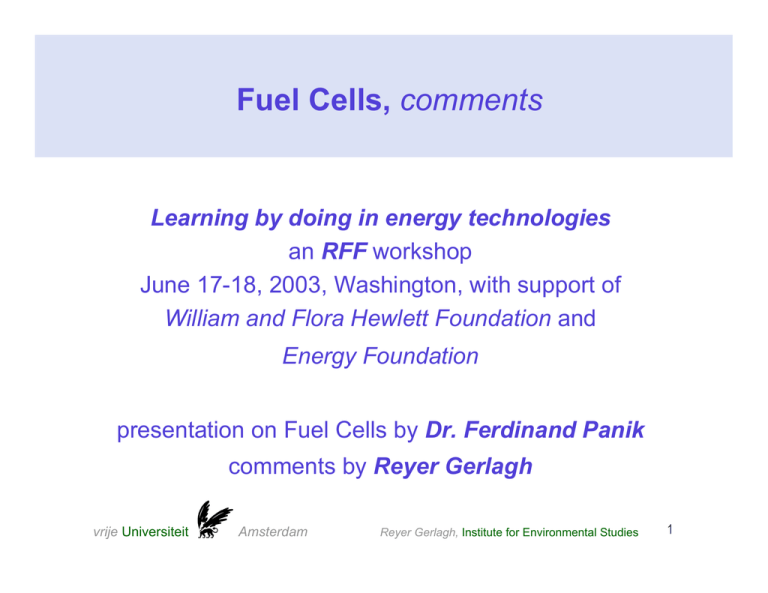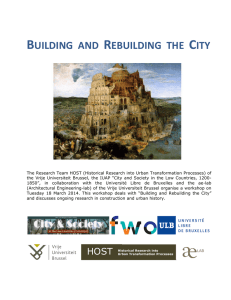Fuel Cells, Learning by doing in energy technologies RFF
advertisement

Fuel Cells, comments Learning by doing in energy technologies an RFF workshop June 17-18, 2003, Washington, with support of William and Flora Hewlett Foundation and Energy Foundation presentation on Fuel Cells by Dr. Ferdinand Panik comments by Reyer Gerlagh vrije Universiteit Amsterdam Reyer Gerlagh, Institute for Environmental Studies 1 Issues Five questions in invitation: 1. What are benefits of low-cost Fuel Cells? 2. Can we predict/extrapolate the experience curve? 3. How fast can we drive down the experience curve and is this costly? 4. How to include the experience curve in CGE/CC models 5. Are supporting policies warranted, and what are their costs? vrije Universiteit Amsterdam Reyer Gerlagh, Institute for Environmental Studies 2 1. What are benefits of low-cost Fuel Cells? Benefits of FC cars are mostly environmental (lower emissions of fine particles and CO2) vrije Universiteit Amsterdam Reyer Gerlagh, Institute for Environmental Studies 3 2. Can we predict/extrapolate the experience curve? Experience curve (Technology Model) = IRS (CGE) It is too hard to disentangle empirically various sources for IRS: R&D vs. LbD vs. Set up Costs, inter/intra-firm spillovers, intertemporal spill-overs, etc. But it is also unnecessary. What matters is: Free entry/exit results in Average Cost Pricing s* = 1–MC/AC, only depends on the IRS-factor s* is probably not lower for matured technologies vrije Universiteit Amsterdam Reyer Gerlagh, Institute for Environmental Studies 4 3. How fast can we drive down the experience curve and is this costly? Learning Costs for FCs is low (< 1 billion $, 2010?) Learning Costs for FC cars is moderate (1-10 billion $, 2020?) Learning Costs for H2 distribution and storage is huge (> 10 billion $, 2050/2100?) Succes of FC cars depends on co-evoluation with H2 suppliers (renewables) and other use of H2 vrije Universiteit Amsterdam Reyer Gerlagh, Institute for Environmental Studies 5 4. Can we include LbD in CGE/CC models Yes, when interpreting as IRS (black box) Be cautious aggregating IRS and DRS technologies What is elasticity of substitution between aggregate technologies (VES)? Equilibria become less stable when IRS technologies are substitutes vrije Universiteit Amsterdam Reyer Gerlagh, Institute for Environmental Studies 6 5. Are supporting policies warranted, and what are their costs? There are 2 possible reasons for stimulating renewables (e.g. wind energy, solar energy, FCs) vs. fossil fuels 1. Renewables have higher returns to scale or fossil fuel technologies have diminishing returns due to resource scarcity (e.g. CO2 constraint) (carbon tax > Pigouvian level) 2. Elasticity of substitution between renewables and fossil fuel technologies is too high for renewables to take off on own steam, but they are superior vrije Universiteit Amsterdam Reyer Gerlagh, Institute for Environmental Studies 7 6. on Climate Change policy and FCs To constrain climate change, an energy transition is essential A carbon tax / emission permits / standards is the most simple, and most effective instrument to set this transition in motion Direct stimulation of R&D is also effective Buying low-cost FC technology is costly, unless markets can be exploited for which FCs are competitive at an early stage vrije Universiteit Amsterdam Reyer Gerlagh, Institute for Environmental Studies 8 ¾ Benefits of Fuel Cells as Drive Unit Fuel Cell cars are mostly substitute for ICE cars, and offer limited new services Fewer moving parts (potentially low costs?) Cleaner environment (fine particles?/CO2) Disadvantage: Reduced range (meth:2; H2:10) Disadvantage: Large fuel tank Barrier: Fuel supply and distribution vrije Universiteit Amsterdam Reyer Gerlagh, Institute for Environmental Studies 9 Can we extrapolate the experience curve? ln(costs per unit) Early phase of rapidly increasing knowledge Second phase of slowly increasing knowledge 20% Matured 10% 0% ln(cumulative output) vrije Universiteit Amsterdam Reyer Gerlagh, Institute for Environmental Studies 10 Comment on the experience curve Typical learning curve measures increasing returns to scale as if time has no impact ln(ct) = α + β ln(zt) β<0 TC costs żt = yt P=AC MC cumulative output vrije Universiteit Amsterdam Reyer Gerlagh, Institute for Environmental Studies 11 Suggestions for the experience curve What should the learning curve measure? 1. (Increasing) returns to scale 2. connectedness of production (scale advantages) over time For this, typical learning curve should be extended with a ‘time filter’ to correct for 1. ‘forgetting’ over time 2. increasing/decreasing production costs over time, e.g. due to increases in wages / other technologies vrije Universiteit Amsterdam Reyer Gerlagh, Institute for Environmental Studies 12 LBD Monopolistic Competition Model Max ∫e–rt (ptyt – ctyt) dt s.t. yt = ψ(pt;Nt) (λt) ct = e γ t zt–βφ(N) Zt–β(1 – φ(N)) (µt) żt = yt – δ zt (ηt) Aggregation: Yt = Nt yt = χ(pt); Zt = Nt zt ψ(pt;Nt) = firm’s demand function; ψp(.;.)<0 φ(Nt) = firm’s internal spill-over rate; φ(1) =1, φ′(.)<0 vrije Universiteit Amsterdam Reyer Gerlagh, Institute for Environmental Studies 13 Model’s results Monopolistic supply => markup on marginal costs: pt = (1 + αt)(ct – ηt), where αt = 1/(σ(Nt)–1) where σ(yt;Nt)=ptψp(pt;Nt)/ψ(pt;Nt) Free exit: ∫e–rt (ptyt – ctyt) dt ≥ 0 Free entry: ∫e–rt (ptyt – ctyt) dt ≤ βφ(Nt)ct/(1–βφ(Nt)) Steady state: c ≤ p ≤ (1+(r–g)βφ(N)/(1–βφ(N))) c SS = Almost Average Cost Pricing: c ≤ p ≤ 1.05 c SS: ct = e (γ–gβ) t (Y0/(g+δ))–β N βφ(N) vrije Universiteit Amsterdam Reyer Gerlagh, Institute for Environmental Studies 14 Extended experience curve Extend learning curve ln(ct) = (α + α1ln(N)) + β ln(zt) + γ t α1>0; β < 0; γ > 0 żt = yt – δ zt δ>0 Back-of-the-envelope estimates (high aggregation level) γ ≈ 0.75 %/yr (efficient wage costs increase) β ≈ – 0.25 (gy = gz = 3%/yr, ct constant) New high-growth technology gy = gz = 20 %/yr ; gc = – 4.25 %/yr ; gc / gz = 21% vrije Universiteit Amsterdam Reyer Gerlagh, Institute for Environmental Studies 15 Reinterpreting the experience curve ln(costs per unit) Rapid growth (20%/yr) Moderate growth (5 %/yr) 20% Saturated growth (3%/yr) 10% 0% ln(cumulative output) vrije Universiteit Amsterdam Reyer Gerlagh, Institute for Environmental Studies 16 ¾ Experience curve implications 1. Matured technology is also subject to IRS (knowledge costs of replacing fossil fuel technology > 6%) 2. A technology being replaced becomes more expensive 3. Fall in costs will continue as long as new technology maintains momentum 4. The (simple) experience curve becomes steeper when new technology receives additional support, and flatter when new technology looses momentum 5. Choice for future technology is undetermined vrije Universiteit Amsterdam Reyer Gerlagh, Institute for Environmental Studies 17 Numerical illustration from DEMETER-2E Business as Usual log production costs 2.5 2 1.5 1 0.5 0 -2 0 2 4 6 log cumulative installed capacity BAU TAX20 Learning curve for renewable energy sources BAU versus Carbon-tax policy vrije Universiteit Amsterdam Reyer Gerlagh, Institute for Environmental Studies 18 Riding down the FC experience curve With currently known technology, costs come down to Costs of FC cars: 2xbenchmark, at 100.000 cars/yr. Costs of FC’s: 1000 $/car (50 kW), at 300.000 cars/yr. Assuming Learning Rate of 20%, costs could halve for every 20-fold increase in sales FC cars become competitive at 2 million cars/yr. Potential for substantial further cost-reduction at further increasing market share ? vrije Universiteit Amsterdam Reyer Gerlagh, Institute for Environmental Studies 19 ¾ Costs of riding down the experience curve Production Costs per Unit: c = α z –β Total Production Costs = c y = α y(1–β) y Cumulative Costs = ∫0 α z –β dz = α y(1–β)/(1–β) Total Learning Costs = CC – TPC = β /(1–β) TPC Assume Learning Factor β of 20% TLC FCs (100.000 units) = 100 million $ TLC FC cars (2 million cars) = 6.5 billion $ vrije Universiteit Amsterdam Reyer Gerlagh, Institute for Environmental Studies 20 ¾ Experience curves in CGE/CC models IRS is consistent with endogenous growth models IRS tends to increase with the aggregation level Source of IRS (set up costs/non-rival knowledge) is less important Practical suggestion: yt = Atη kt α lt(1–α); At+1 = At(1–δ) (λyt)δ Alternative: yt = Atη/(1–α) kt α lt(1–α); At+1 = At(1–δ) (λlt)δ Implication: long-term equilibrium becomes more sensitive to policies and parameter variations vrije Universiteit Amsterdam Reyer Gerlagh, Institute for Environmental Studies 21 IRS and technology choice Consumer Indifference Curve (iso-utility-line) FC cars FC cars Consumer Indifference Curve (iso-utility-line) Production Set ICE cars vrije Universiteit Amsterdam Production Set ICE cars Reyer Gerlagh, Institute for Environmental Studies 22 Two possible technology futures FC car costs per unit costs per unit FC car ICE car FC subsidy vrije Universiteit ICE car FC subsidy Amsterdam Reyer Gerlagh, Institute for Environmental Studies 23 14 14 12 12 10 10 ($/GJ) ($/GJ) Numerical illustration from DEMETER-2E 8 6 8 6 4 4 2 2 0 2000 2050 BAU Fossil Fuels 2100 2150 BAU Renew ables Business as Usual vrije Universiteit 2200 Amsterdam 0 2000 2050 TAX20 Fossil Fuels 2100 2150 2200 TAX20 Renew ables Carbon-tax policy Reyer Gerlagh, Institute for Environmental Studies 24 The future of Fuel-Cell Cars FC cars are a technological improvement (fewer moving parts) FC cars have potential for a break-through FC cars have limited customer advantages (noise) FC cars have serious customer disadvantages (range) FC cars will not break-through on their own steam vrije Universiteit Amsterdam Reyer Gerlagh, Institute for Environmental Studies 25 ¾ Policy Implications neglecting resource/factor use 1. Both FC and ICE technology may have Increasing Returns to Scale, that may exceed 20% 2. The ratio MC/AC as the basis for subsidy is possibly the same for FC and ICE technologies. 3. Subsidizing FC technologies (when in contrast to ICE technologies) to overcome learning costs is unwarranted vrije Universiteit Amsterdam Reyer Gerlagh, Institute for Environmental Studies 26 ¾LbD/IRS & Climate Change Climate change is main reason for stimulating (a transition to) FCs. When fossil fuels are considered exhaustible, or cumulative CO2 emissions are constrained because of Climate Change, ICE may be subject to diminishing returns compared to FCs LbD/IRS warrants extra stimulus for FC optimal carbon tax = Pigouvian level + IRS compensation = win/win vrije Universiteit Amsterdam Reyer Gerlagh, Institute for Environmental Studies 27 FC and climate change policies Generic carbon tax / emission standards Advantage: minimal public information costs (government does not need to choose between technologies) No costs of public funds Disadvantage: Gap between FCs and ICE may be too wide to be bridged by tax-induced price wedge vrije Universiteit Amsterdam Reyer Gerlagh, Institute for Environmental Studies 28 FC and government purchase Government purchases of (expensive) FC cars Advantage: Reduced uncertainty for both government and producers => stimulates investments Disadvantage: Possibility of lock-in in inferior FC technology Use of (expensive) public funds vrije Universiteit Amsterdam Reyer Gerlagh, Institute for Environmental Studies 29 FC and knowledge policy Government stimulates sharing knowledge / reduces fragmentation Advantage: directly stimulates producing knowledge lower costs of production Disadvantage: Possibility of too monopolistic behavior of ‘owners’ of technology vrije Universiteit Amsterdam Reyer Gerlagh, Institute for Environmental Studies 30 ¾ FC policy: walking on two legs Is FC car superior to ICE car? Development of FC is co-evolution of FC technology and hydrogen/methanol infrastructure Stimulate development of FCs through stepping stones (Exploit all niche markets for FCs to spread learning costs) Stimulate renewables conversion into H2? Required policy is transient (but still long-lasting and costly) vrije Universiteit Amsterdam Reyer Gerlagh, Institute for Environmental Studies 31


